In this issue
Network News
Features
Owl Rescue

A Boobook Owl chick, too young to leave the nest, is found on the forest floor. Will it survive?
Our ‘resident ecologist’ Guy Dutson was walking in the forest one morning when he came upon a small wet and bedraggled owl sitting on the forest floor. Guy thought that it had fledged prematurely from its nest but was too young to fend for itself and appeared to be too wet and weak to fly. He carefully placed the chick, a Southern Boobook Owl, on a nearby branch close to where he found it and away from the path and predators.
That evening, Guy returned to find the little owl still standing strong on the branch where he had left it. He was delighted to find that one of the parent owls was standing guard on a different branch nearby. He assumed that the parent bird would still be feeding the baby.
Guy invited us to view the owls at dusk. What a treat! The chick was clearly visible through a telescope and we were able to stand quite close without disturbing it. We could also see the parent Boobook Owl nearby. Wildlife photographer and NEV family member, Richard Yank, was visiting the village and he took the accompanying photographs.
A few days later, Guy reported the Boobook Owl chick and parent had moved on, hopefully to greener pastures where the baby could now feed itself without the parent’s assistance.

Avoiding mould: Drainage, Eaves, Gutters and Roofs (Healthy Homes #2)

In part 2 of this series, Narara Ecovillage member Mikala Dind continues to share her knowledge about what makes houses healthy or unhealthy.
One of the most common causes of mould problems in a home is water finding its way into the building. In fact, keeping water out of buildings is one of the most fundamental aims of building/landscape design. If these principles are skipped or corners are cut, then the home will become a ticking time bomb, with potentially cascading problems and increasingly expensive repairs.
While these articles are designed with the new home builder in mind, the principles outlined can be used to assess/improve any existing home.
Good drainage is essential
As you know, water will find the path of least resistance, so if you don’t redirect it away from the home, it will find its way in, either directly or indirectly.
Sloped sites
Sloped sites need both surface and subsurface drains in ground that is higher than the home to move surface and subsurface water around it. These sites have the benefit of gravity at their disposal.
Something that’s occasionally overlooked is including a drain at the front of the garage where the driveway runs downhill towards the house. I get concerned when builders rely solely on angling the driveway to direct the water away from the garage. Again, it may work 90% of the time, but it’s that 10% that causes trouble – when water gets into the garage it can damage items stored there, and dampen the slab, increasing humidity in adjacent rooms.
Flat sites
Flat sites also need drainage. However, they need to create their own “fall”, using either drains or earthworks to make the land go downhill from the home, so water is drawn away from the house.
Keep slab edges and the base of walls exposed at ground level
A house built on a cement slab needs 75mm of the slab exposed, both to reduce the likelihood of water intrusion, and to make any termite attacks easy to see (as in the photo below).
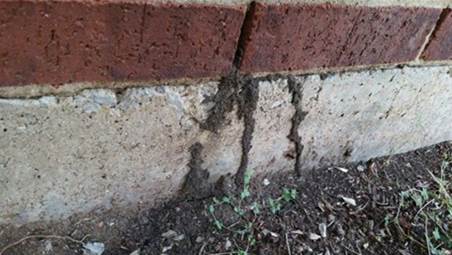
Termites building their way past the cement slab to enter a home
Often gardens are built right up against the home, which can lead to water ingress into the home, increasing humidity in the rooms behind that wall, and hiding termite incursions. Keep gardens, mulch and compost well away from walls. Another consequence is that airborne mould spores from the garden (eg decaying mulch) can enter the home through windows.

Garden built up against a wall, actually causing flooding inside the home during rain
During one mould audit it started to rain (usually something that makes my job more difficult). However, my client, who rented the property, was thrilled. Why? So she could show me how the downstairs laundry (that we had already inspected) gets its own little river coming out from under the laundry cabinet when it rains. The real estate agent had not believed her claim of the flooding, but there it was for all to see about 30 minutes after the rain began.
The reason? The owners had built a garden up against one of the home’s walls (see photo), covering the weep holes in the brickwork. The result was that water now trickled into the double brick wall cavity, rather than weeping out of it.
If structural timber is allowed to remain damp over time, it becomes an open invitation for termites who find damp timber easier to chew through. Thus ensure that all timberwork that has been in contact with water (from flooding/leaks etc) has been thoroughly dried to reduce the likelihood of mould growth and/or termite attack.
Eaves, Gutters and Roofs

The importance of eaves
Somewhere along the line, eaves started being uncool. That’s a shame because they protect your home. They keep your windows (particularly wooden framed ones) dry, thus reducing the likelihood of water ingress (eg through wood rot). They also keep the ground abutting your home drier, reducing the likelihood of bricks and mortar becoming damp and increasing the humidity in the home.
The more your window frames are in contact with sun and rain, the more weathered they will become (which will lead to greater maintenance costs to prevent water intrusion through unnoticed wood rot). Again, note which side(s) of the house get the predominant weather (especially storms).
Over-engineer gutters
Gutters and downpipes may not be aesthetically pleasing, but they perform a vital function – to remove water off the roof and into storm water pipes before it can do any damage. Not enough downpipes, or guttering with a higher outer lip, can almost guarantee that rain will find its way into the roof cavity, potentially damaging the structural integrity of the roof and encouraging mould growth.
I always recommend that my clients spend the money to over-engineer their gutters, downpipes and drains so that they reduce the risk of water getting into their home (either via the roof or the floor). Also, don’t skip the gutter guard. Keeping gutters and downpipes clear of leaves and debris ensures they can work to their full capacity.
It only takes one event of water ingressing into the home and much damage, (both seen and unseen,) can be done.
Avoid flat roofs and/or hidden guttering
Another fad with even more drastic consequences is the flat roof and/or hidden guttering. Please run a mile from either of these architectural catastrophes. Roofs need to have a decent pitch/fall (15% or greater) so that rain is forced by gravity towards the gutters, and wind cannot easily push rain uphill and into the roof cavity (eg via the ridge cap). I did an audit once where the roof over the outside entertainment area (connected to the building just above the back door) was actually pitched towards the building, creating really bad humidity and water damage issues.
Today’s take-away tip – Keep Hot Water Tanks outside
Having a hot water tank inside is a recipe for a potential disaster and so is something I warn against. In my current home the original design called for the hot water tank to be in a cupboard above the pantry. I strongly opposed this design and insisted that the tanks be located outside. If they leak while hidden in a cupboard they can do thousands of dollars damage before you’re even aware of it. If they fail completely the greater volume of water can come into contact with way more cupboard surface, as water can get into every nook and cranny.
If your external hot water tank is a long way from your kitchen/bathroom (and your house is built on piers – ie you have a subfloor crawl space), you can install a ring loop that runs from your hot water tank to your bathroom and kitchen and back again. You then install an in-line pump (on a timer) that sends hot water around the ring loop so that you don’t have to waste water waiting for the hot water to come through.
You may be wondering why I keep harping on about humidity … well, you’ll need to wait until the next instalment as I will discuss the relationship between humidity, dust and mould.
Village News
Great progress on floodplain – Saving Swifties
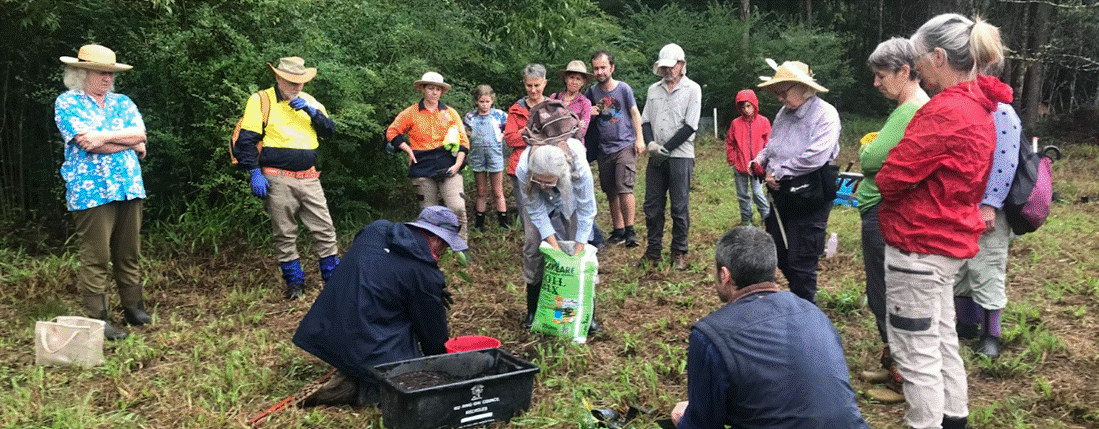
-Teresa Farrell
At a morning workshop, enthusiastic participants took great steps towards restoring the plant community along Narara Creek, and establishing future winter feeding for the critically endangered Swift Parrot.
Floodplain-appropriate species were carefully selected, and steps demonstrated for protecting the young trees from wallabies.
Details about species planted here, along with how-tos & links to more information about Swift Parrots and the program:
Check out our third and final workshop on Fri 26 May 2023
About the project: to rehabilitate a stretch of land on the edge of our wetlands, creating a corridor of Swamp Sclerophyll and Rainforest habitat that will provide winter food plants for the critically endangered Swift Parrot.

We really were very thrilled at the enthusiastic attendance for this workshop, which was made possible with grant funding provided by Greater Sydney Local Land Services (LLS) and supported by professional bush regenerators from the Community Environment Network (CEN). We had a total of 24 participants at the workshop, including two representatives from LLS, Dan Keating and Mick Budden, two professional bush regenerators from CEN, Ben and Emma, and five village members who organised the morning. As always, we enjoyed a yummy morning tea catered by Candy and her crew.
The planting of more than 300 plants, completed during our two workshops, has met our commitment for this project and will provide a great start to replacing the overwhelming weeds that have occupied this area for a long time.
Despite impending rain and storms, our ‘Save a Swifty’ workshop turned out to be a very productive day. Participants planted a total of 177 plants, including 46 Swamp Mahogany trees (Eucalyptus robusta), and a mix of trees and grass-like plants (Dianella and Lomandra) to re-establish a plant community pushed out by the mass of privet. The species planted were:
- Scientific name Common Name
- Glochidion ferdinandii Cheese Tree
- Ficus coronata Sandpaper Fig
- Acacia irrorata Green Wattle
- Acacia maidenii Maidens Wattle
- Callistemon salignus Willow Bottlebrush
- Lomandra Lomandra
- Dianella caerulea Blue Flax-lily
Everyone enjoyed the day, improving their knowledge about the habits of the Swift Parrot, and what is required for planting out in a floodplain with curious large animals. For further information of events and advice please look at the Narara Ecovillage website, Greater Sydney Local Land Services website and Community Environment Network website.
If you’re interested in learning more about the swift parrot and regent honeyeater, Mick Budden has provided the link to the Swift Parrot/Regent Honeyeater webinar, see below: https://vimeo.com/599510135
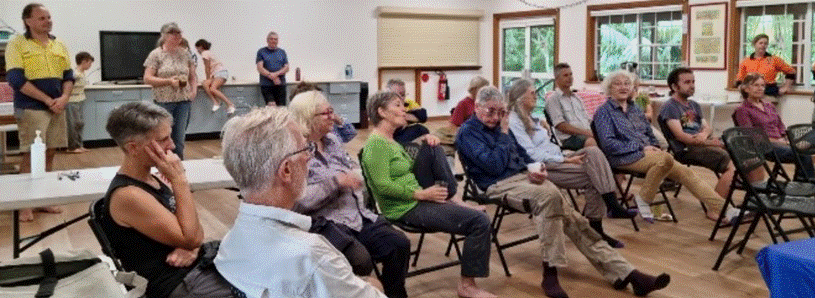
Here’s a little recap of what we did for planting the Swamp Mahogany trees on the day.
- Dug a hole a little larger than the pot, using helpful tools such as Hamilton Bar
- Mixed in some compost
- Removed the plant from the pot, placed it deep in the hole, and backfilled with soil & compost.
- Placed a jute mat square around tree, pinning it down so it won’t wash away during heavy rain
- Watered in the plant
- Installed wire mesh cages around the tree, to protect it from curious & hungry wallabies
- Hammered in three stakes to hold the cage into place, remembering that the swamp wallabies are large and strong creatures, who could push over a less well secured cage.
- Stood back and admired a job well done!
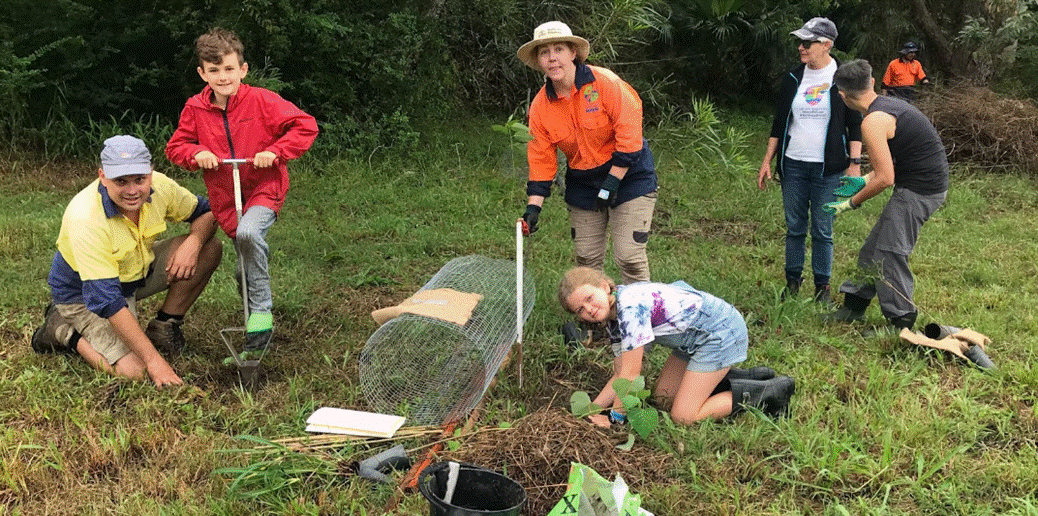
Gaining a deeper connection with nature: Deep Ecology and Nature Meditation Weekend
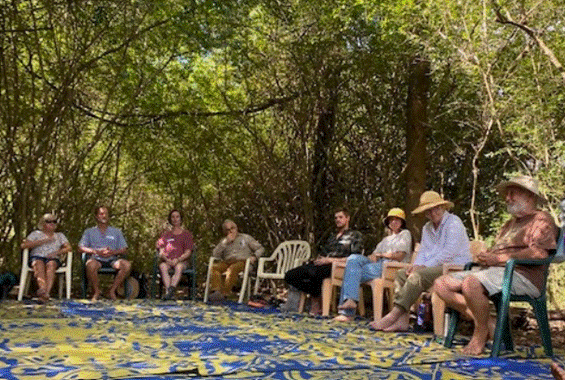
-Suzie Brown and John Seed
We were very happy to welcome 25 participants to experience our Deep Ecology and Nature Meditation Weekend in March.
Deep Ecology is a philosophy of nature that sees that underlying the environmental crisis there is a psychological disease stemming from the illusion of separation between humans and the rest of the natural world. Visitors loved the program and commented on connecting with nature and history of the area. Read on for more about the workshop:
Our workshops were a wonderful opportunity to allow people to experience and connect to the beautiful natural areas of the village and surrounds, such as Strickland forest and Narara Creek, the rural blocks, the campfire circle and the dam. We also initiated a new Deep Ecology space on our southern rural block where an old greenhouse frame has been repurposed into a sheltered meeting space surrounded by trees.
Deep Ecology is a philosophy of nature that sees that underlying the environmental crisis there is a psychological disease stemming from the illusion of separation between humans and the rest of the natural world. The weekend included Deep Ecology processes such as opening our hearts and minds to the love and the grief we feel for our world which is deeply regenerative and allows us to access a deep well of experience, perspective and creativity to empower our actions on behalf of the Earth.
John Seed was delighted to be using “Angkor Wat,” the new green space cleared in a couple of weekend working bees on the southern rural lot. What had been a dense thicket of lantana and privet had been carefully pruned so as to leave the canopy intact, creating a delightful shady, green grotto big enough for 40 people to sit in a circle right beside the new plastic-covered area sitting ready in case of rain. “It is Wonderful!” he said, “to see those weeds being transformed from a bug into a feature. The perfect environment to experience deep ecology and the awakening of our ecological identity and feel a sense of connection with the living Earth.”
Nature meditation included sessions by the creek and in the forest as well as mindful walking with Mindfulness teacher, Suzie Brown and – with special guests Guy Dutson and Ben Smith – bird watching and listening and weed foraging. Plus there were lots of opportunities to make meaningful connections with each other.
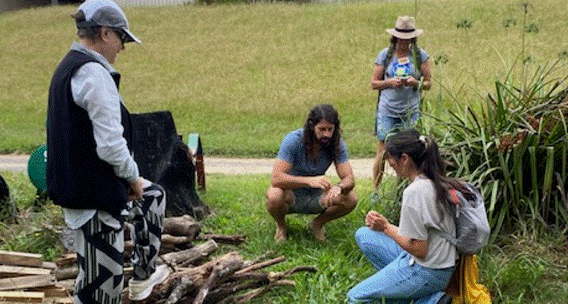
Visitors enjoyed meeting the locals as they stayed in village homes or camped in our campground, and delicious food was provided by Candy and the Coffee Cart team. We were blessed with temperate weather and everyone seemed to have a fantastic time!

Events
Sun 7 May: Howard Enyon Concert

”Virtuoso guitar playing and utterly fantastic and original songs … one of the most enthralling musical experiences of my life” – John Seed
- When: Sun 7 May, 7-9pm
- Where: Narara Ecovillage Hall, 33 Gugandi Road Narara
- Cost: $20, KIDS $5
- More info & Registration: https://events.humanitix.com/howard-eynon
Fri 26 May: Save the Swift Parrot Project – 3rd & final workshop!

Learn how to maintain a planted area to enable native vegetation to regenerate. Guidance on weed identification and management, and prioritisation of activities to make the biggest difference over time.
This is our final workshop (of three) in this project, so don’t miss out! All welcome- no need to have attended previous workshops. Bring your friends!
- When: Friday 26th May, 8.30am to 12md
- Where: Narara Ecovillage Hall, 33 Gugandi Road Narara
- Cost: FREE – only 30 spaces for this final workshop in this series (delicious morning tea included)
- More details and Registration here
Sat 27 May: Narara Ecovillage Open Day

The Open Day (talk and tour) shows what Narara Ecovillage is all about, and demonstrates how we are activating a resilient community with ecological, social and economic potential. All welcome.
- When: Sun May 27, 10.30am – 1pm
- Where: Narara Ecovillage Hall, 33 Gugandi Road Narara
- Cost: $15 includes talk & walking tour around village, kids free!
- More Details and Registration
If this is your first visit to Narara Ecovillage, you may find this interesting: the Open Day Preview introduces the ecovillage and its unfolding story.
Sat 3 June: Friends of COSS Workshop
Central Coast Council manages a network of bushland and other natural reserves in the Coastal Open Space System (COSS). These reserves are places where our native plants, animals, fungi and other living organisms can thrive.
Find out how you can help!

- When: Sat 3rd June, 9am-12pm
- Where: Wildplant Community Nursery, UoN Ourimbah
- Cost: free, but there is also a plant sale
- More info/registration: Just turn up!!
The Community Environment Network (CEN): at our Wildplant Community Nursery at Ourimbah, we propagate the flora of the Central Coast Region. Our purpose is to promote and grow local-provenance native plants for the public, our members, and our many projects.
Fri 18- Sun 20 Aug: Experiential Deep Ecology Weekend Workshop

The Rainforest Information Centre presents DEEP ECOLOGY with John Seed, Carly Walker-Smith & Allison Tsao. We will challenge the illusion that humans are separate from the rest of the natural world.
- When: 4pm Fri 18- 4pm Sun 20 August
- Where: Narara Ecovillage, 33 Gugandi Road Narara
- Cost: $200 to $800 (incl all meals)
- More info & Registration: https://events.humanitix.com/deep-ecology-with-john-seed-and-friends-narara-ecovillage-aug-2023
- NELN members 10% discount – when you register click on “hidden tickets” and then enter “NELN” in the code field.
25% of proceeds to rainforest conservation
What’s On at Narara Ecovillage – any time
Ecoliving Podcast #6
Cost-effective environmentally-friendly retrofitting a large heritage timber house
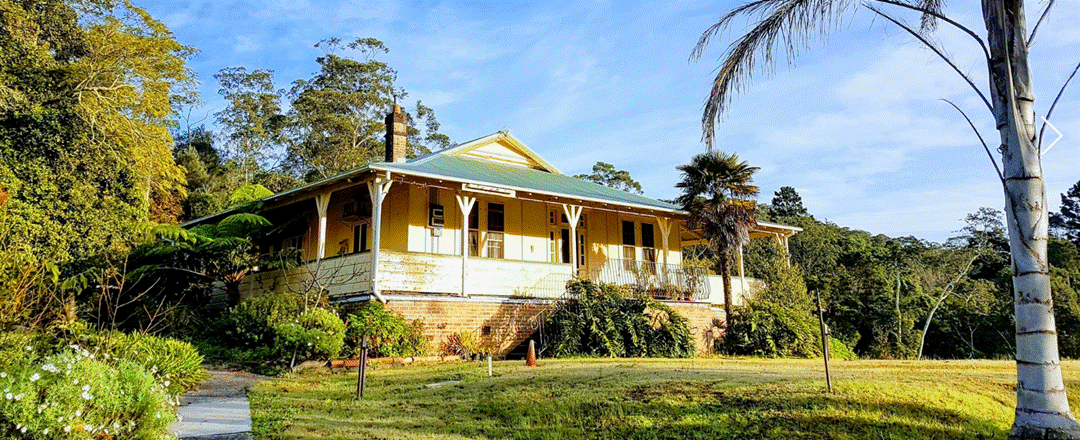
This 18-minute episode features village member Mark O’Brien talking about Renovating a Heritage Home to make it more comfortable and environmentally-friendly.
Listen here
Contact the Network News Editors network.news@neln.org.au
About the Network and the Village

The Network
The Narara Eco Living Network is a not-for-profit educational and outreach body established by members of Narara Ecovillage to foster more sustainable living in all its forms and promote the vision of the village.
We publish the Network News and run networking & educational events and community projects.
Become a supporter of the Network – 12 months membership is only $20 an individual or $40 a family. Networkers are offered discounts to a variety of events at the village, and free entrance to Open Days. Click here to check out upcoming events at the village. The network is 100% run by volunteers so we really appreciate your support!

The Ecovillage
Narara Ecovillage is a community that blends the principles of ecological & social sustainability, good health, business, and caring. We are located on the NSW Central Coast at 33 Gugandi Road, Narara 2250. Click here for more info about Narara Ecovillage

